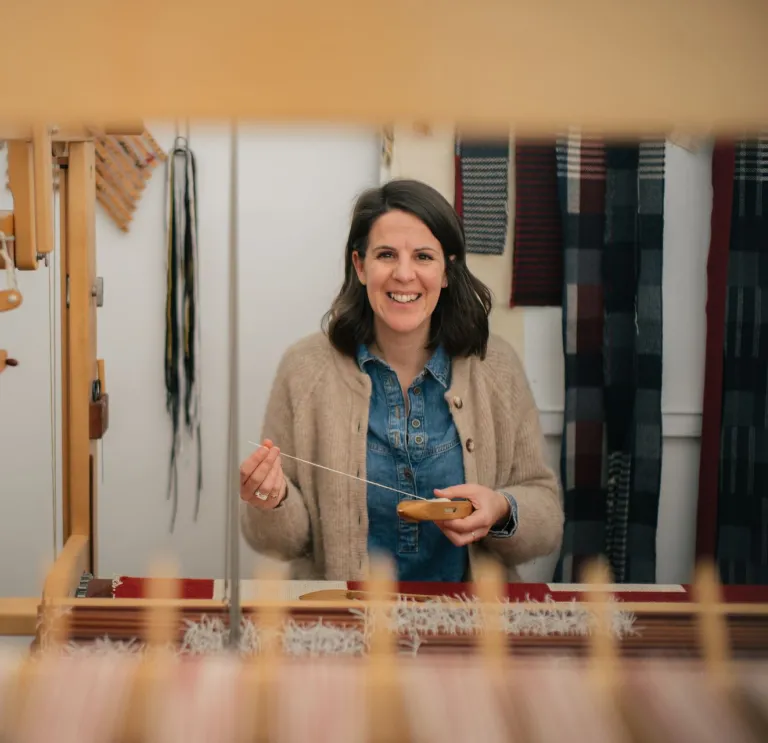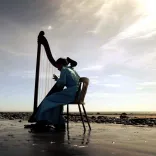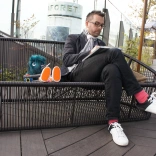Wales has long been a country of remarkable creativity and craftsmanship, with the epic landscapes and cultural traditions inspiring generations of artists and makers. Among these crafts, textile design and hand weaving hold a special place. For centuries the rivers of Wales powered woollen mills, a thriving industry that once employed thousands of artisans.
Although the number of mills might have dwindled, there are still textile artists like me, who are fascinated by the craft. Although I've worked in different jobs across the industry, these days I design and weave for my own brand, ‘Llio James’.
I also create commissioned pieces, such as bespoke blankets, cushions or scarves, and design fabric that’s manufactured in the UK. I’m currently based in Cardiff, and I work with a micro mill in Bristol (Bristol Weaving Mill) to manufacture 100 percent British Wool cloth.


Wales has a very long historic connection with the textiles industry, mainly because of the wool we produce. Historically, textiles were one of the main economic drivers in Wales. The rivers of Wales powered around 350 woollen mills in the 1860s, producing blankets, shawls, stockings and flannel. In Mid Wales thousands of people were employed as weavers, spinners, dyers, knitters, drapers and tailors.
During the Industrial Revolution, the Welsh woollen industry was slow to mechanise compared to the mills of northern England, with manufacturing starting to dwindle between the 1920s and 1960s. By the 1970s, there were only 24 woollen mills left in Wales. Today, that number has fallen to just a handful. I’m not sure if we’ll ever get back to how manufacturing used to be in Mid Wales, but I’m sure we’ll never lose the art of hand weaving.



I first started working with textiles during an Art & Design foundation course in Cardiff. I realised there was so much more to them than I had originally perceived. I began to understand how important textiles are in all aspects of our everyday life.
Think about it. We’re born, and wrapped in cloth. We put on clothing that covers ours skin every day. Our feet walk along carpets, we sit, drape and lounge on materials that support and comfort our bodies. Textiles and texture are everywhere. At that point the penny dropped for me.
I was lucky enough to study ‘Textiles: Knit, Weave and Print’ at Manchester School of Art, which is where I learned how to weave and construct cloth. Since then, I’ve had experience in different aspects of the textiles industry, from working in a heritage centre in South Wales, to being employed as a textile designer in New York and Scotland.
As a textiles designer, it’s really important to me to weave by hand.
In my own work, most of my projects start off in a similar way – with coloured paper, a scalpel and glue. I find working with my hands and simple materials, like paper, can easily build up visual ideas. I cut various paper shapes, stripes and motifs, and can easily vary the scale and colour combination to see what design works best. From there, I’ll narrow down a handful of designs and start to work digitally. Either with a specific digital weave programme, or Excel, I start to build a design that works full scale. Once I’m happy with a design, I then turn to yarn.
I often use the double cloth weaving technique to produce blankets. Double cloth technique means I can weave two layers of cloth at the same time, giving the blanket striking designs on both sides. We see this technique used in many of the traditional blankets produced from Wales in the 1960s and 1970s. This has a visual significance that represents the work produced by the woollen mills for many years in Wales.
Creating a piece to celebrate the links between Wales and Japan
I started my visual research by looking at the Japanese flag. I love the simplicity of it, and the central focal point. I wanted to have a similar focal point to this piece. I chose to work with Welsh wool, and I set myself a limited (but important) colour palette of natural and red. I usually work on yarn windings/yarn wraps where I wind the yarn around card to see how it sits together, if the design that I’ve come up with looks good in ‘real life’ and if the scale works.


I worked on initial smaller handwoven samples that tested out the yarn quality, drape and handle of the fabric, as well as some design ideas. Once I was happy with the final design I could start measuring and winding the warp, winding it onto the loom, threading every individual yarn end through each heddle, then through the reed, tying the warp ends on to the loom, and starting to weave.
For this piece, I was following a clear design. Sometimes I like to change colours and scale of the motifs as I’m weaving. I’m a handweaver, so I’m able to adapt the work as it’s produced. Like an artist behind the canvas, I’m painting the piece.
This piece took about three days to weave. Once I finished weaving, I hand washed it to soften all the fibres, then hand-finished the piece in my studio in Cardiff.


Every aspect of the blanket is Welsh. That was a key focus of mine not only for this project, but also going forward in my work. I used Welsh wool produced by Cambrian Wool. The wool is beautiful to work with and in contrast to what many think, it’s very soft against the skin. The label was woven by National Weaving, a company based in Narberth.
It’s great to be able to communicate so easily with companies that are only a few miles away. We seem to understand how important it is to support each other and from that you get a great feeling of excitement. Not only do I get to use companies that are local to me, but they’re producing some of the best products available. That’s a great feeling.

My Welsh heritage is a hugely important source of inspiration in my work. It comes from the feeling I have being Welsh and belonging to Wales, the language and the culture. The best way for me to express that feeling is through my work. I explore traditional Welsh designs seen at Amgueddfa Cymru National Wool Museum, St Fagans National Museum of History, or people's personal collections – with the aim of bringing the designs to life into today's world. I like challenging myself by using the feeling I have of being Welsh and by creating something visual. Many motifs or textures connect with people and ignite a feeling of nostalgia. I love thinking about how we can capture that feeling in design and visual work.
Since my first introduction to weaving at Manchester, I have been in love with the process. Starting with just a length of yarn, an idea and some specific techniques you create and build a fabric.
I find that method magical, and love it to this day. Even though the method or craft of weaving is deeply traditional, I feel there’s a need to continuously work on building a contemporary cloth. If we don’t push things forward and create interesting design pieces, then the method behind the making will slowly dwindle. I find that balance quite interesting.
I also feel a great privilege to be doing what I’m doing. I feel lucky that I was introduced to the craft and cherish the time it takes to construct hand-woven fabric.
Follow Llio James online:





